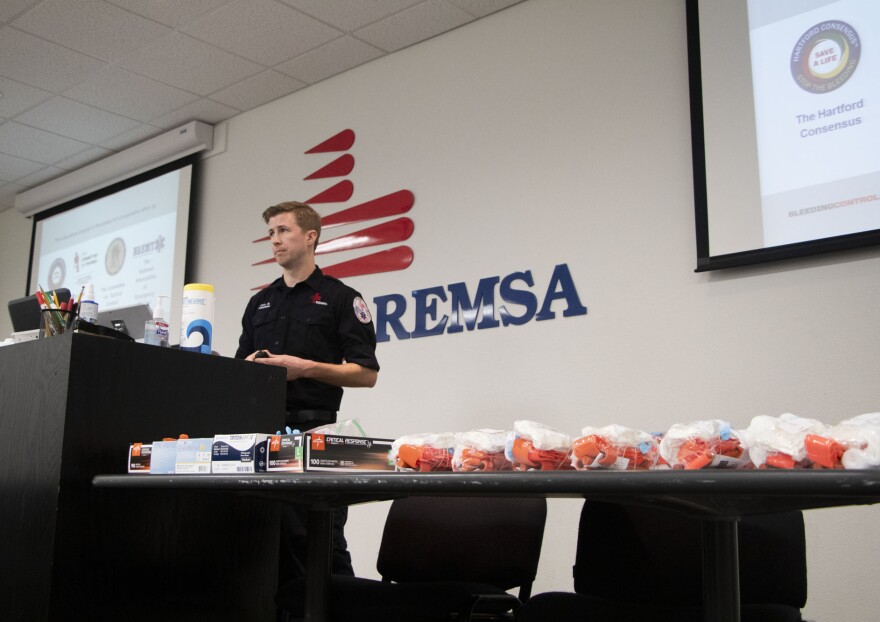Last year, there were 340 mass shootings nationwide. That’s according to the nonprofit the Gun Violence Archive. Mass casualty events can cause mayhem, delaying first responders from getting to the scene quickly. KUNR’s Anh Gray visited a training session for a national campaign called Stop the Bleed, which empowers bystanders to render aid.
A note of caution: The topic we are about to explore may not be suitable for children.
A paramedic is preparing a group of about twenty students for a hands-on class that can get intense. It’s organized by Northern Nevada’s ambulatory service provider, the Regional Emergency Medical Services Authority, or REMSA.
Avery Baldwin is a paramedic with REMSA and coordinates the agency’s local Stop the Bleed program. He says the loss of life from severe bleeding happens in mere minutes and is the most preventable cause of death from trauma.
“As far as the bystander role, it’s huge because we always tell people in the class, the person that is likely going to apply a tourniquet or stop the bleeding is going to be the person sitting next to you,” Baldwin said. “The emergency medical service in the area, they will get there, but they may get there in a few minutes, and we know now that someone can die within a few minutes depending on the injury.”
The deadliest mass shooting in modern U.S. history took place in Las Vegas in 2017. The gunman killed 58 people and wounded hundreds more. It’s been reported that the death toll would have been even higher, but some bystanders provided lifesaving aid. Typical of other incidences, after the tragedy, the Stop the Bleed program in Vegas saw a spike in people signing up.
Since the inception of the program, according to Stop the Bleed, more than 500,000 people have received this training nationwide, and about 13,000 are Nevadans.

“We’ll have them practice on each other; we’ll have them self-apply their own tourniquets and have to use one hand,” Baldwin explained. “We’ll have them critically think through some problems, like, if the first tourniquet fails, what will they do?”
In a class lasting about two hours, Paramedic Cory Rabe is teaching participants how to recognize who needs help.
“Look for and identify life threatening bleeding,” Rabe said, “what we consider life-threatening bleeding [is] blood spurting out of the wound…”
Students practice using several types of tourniquets, including one called the CAT—the Combat Application Tourniquet—designed for military use. Rabe tells them a common mistake is tying a tourniquet too loosely.
“You want to pull it as tight as you can, and then you’re going to secure it," he told a student.
Then he makes the rounds around the class to make sure students get to experience how tight it needs to feel by having it tied on them and having someone tie it on him.
Today’s class is a mix of people who are here for various reasons.
Joey Walker is a retired officer from the Reno Police Department. He was with the agency for 25 years and now teaches active shooter defense to businesses and individuals.
“Well, let’s look at any of the active shooting cases that we know of--people are being shot, they’re in an environment that takes police at least 45 minutes to several hours to clear a facility, depending on the size of the facility,” Walker explained. “And if they’re in an environment where they can’t immediately evacuate, then we need to be able to help that person save their life.”

As for partners Val Weston and J. Brandon, they’re here because they’re outdoor enthusiasts and motorcyclists.
“We’re often alone out in the backcountry; we need to be our best advocates,” Weston explained. “If we’re going to be on our own; if we’re going to be that far from help.”
Brandon said he prefers to be proactive, "...and knowing you have skills is better than swearing at yourself because you don’t have any. We talk about our personal security frequently, we take steps to be as safe as possible and if all of our neighbors did the same thing, our community would be stronger.”
Dr. Lenworth Jacobs also wants communities to be stronger. He’s a trauma surgeon based in Connecticut, with four decades of experience. After Sandy Hook, Jacobs evaluated the medical response to that mass shooting, which killed 26 people—20 were children
“I had to get involved in reviewing this event. It was the single most distressing thing I have done in my career, because these are six-year-olds,” Jacobs said. “You don’t send your six-year-old daughter or son or grandchild to elementary school to be shot to death, and to see that was overwhelming.”
A few months later, the American College of Surgeons—a group of more than 80,000 surgeons worldwide—formed the Hartford Consensus under the guidance of Jacobs. Their work led to the creation of Stop the Bleed, which has adapted military protocols for treating injuries.
“Every soldier that goes to war has a bleed control kit on his person or her person,” Jacobs explained, “and is trained to stop bleeding.”

Stop the Bleed is working to make similar kits more readily available in homes and public spaces like schools, malls and sport arenas. The kits include tourniquets and wound dressings approved by the Department of Defense. Jacobs says that, similar to CPR training, having bleeding control skills can help save lives.
“I felt really strongly that we had to do something that will make a difference in the future,” Jacobs said.
Gun violence has become a normalized occurrence in American life. In 2017, nearly 40,000 people were killed by firearms. That’s according to data from the Centers for Disease Control and Prevention. The Stop the Bleed campaign is attempting to build national resilience to that reality by empowering more people to step in when emergencies strike.








